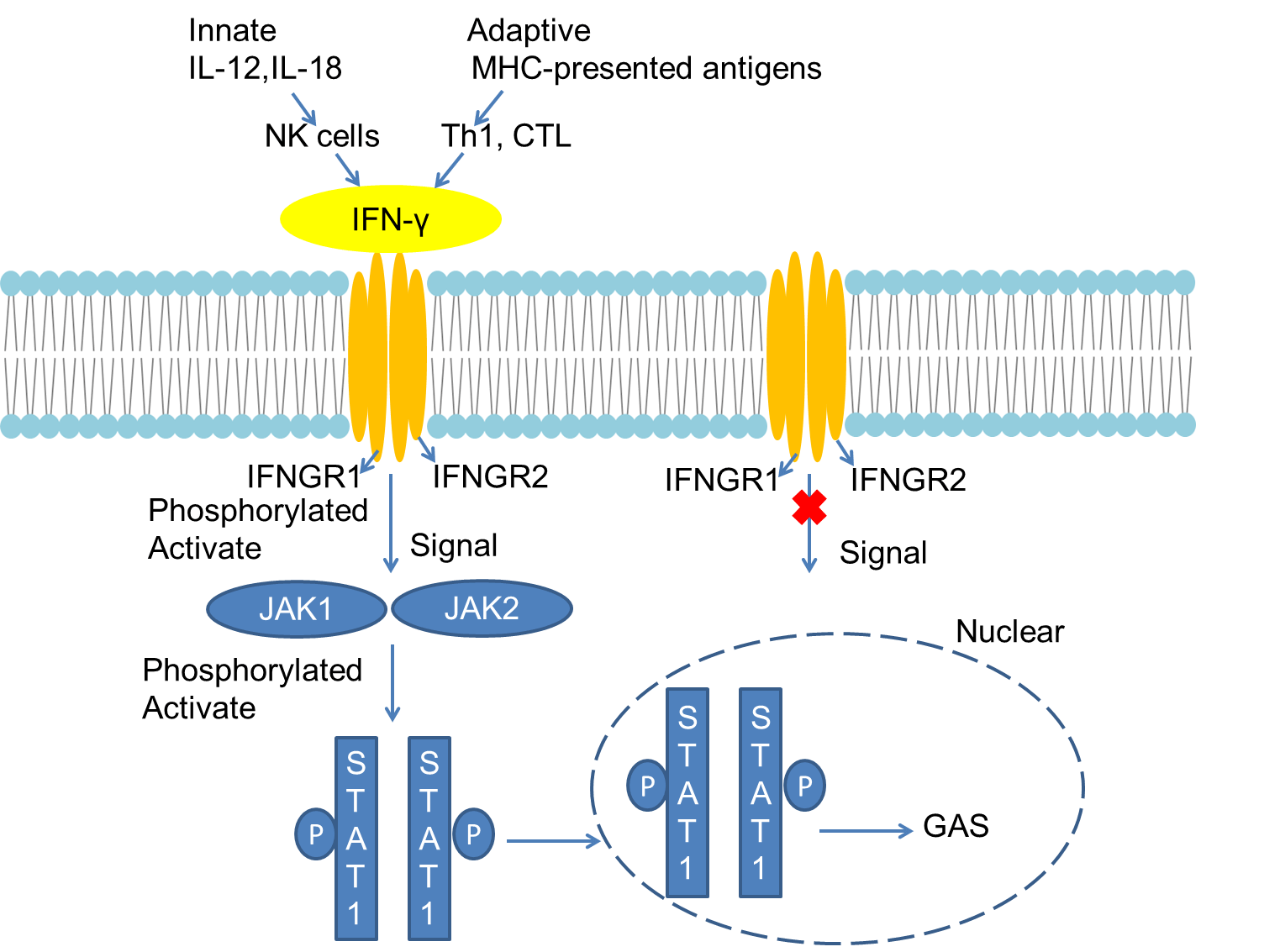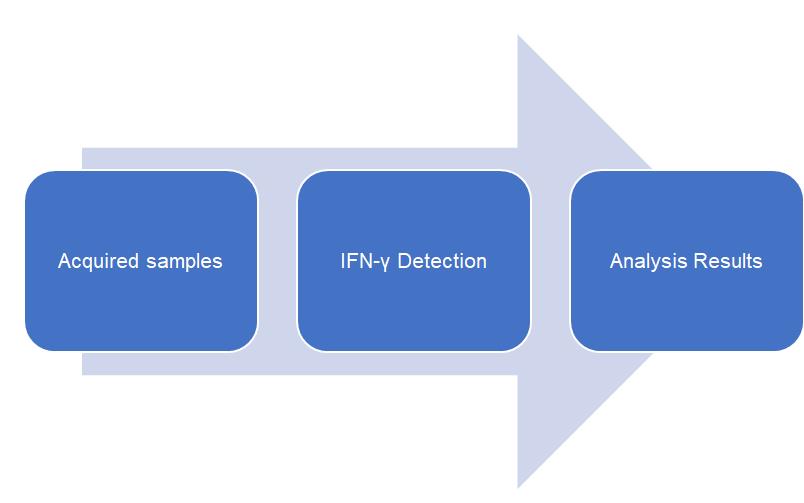Introduction
According to the different primary structure of interferon protein, it is divided into three types of α, β and γ. Interferon gamma (IFN-γ) is produced by immune lymphocytes. The gene structure contains introns and plays an important role in the adaptive immune response. IFN-γ is a multipotent cytokine that can promote macrophage activation, mediate antiviral and antibacterial immune responses, enhance antigen presentation, activate the innate immune system, coordinate the interaction of lymphocytes and endothelial cells, regulate the balance between Th1 and Th2 cells and regulate cell proliferation and apoptosis. In the adaptive immune response, IFN-γ is produced by CD4+ helper T cells (Th1) and CD8+ cytotoxic T cells (CTL) when stimulated by antigens presented by the major histocompatibility complex (MHC). In the innate immune response, IFN-γ is produced when natural killer cells (NK cells) are stimulated by interleukin 12 (IL-12) and interleukin 18 (IL-18).
Mechanism and Function
IFN-γ is secreted by the cells of the immune system, and has the functions of regulating immune response, cell proliferation or apoptosis. IFN-γ regulates the immune response by activating signaling pathways. IFN-γ binds to the interferon-gamma receptor(IFNGR)to cause dimerization of the receptor. Two IFNGR1 chains are combined with one IFN-γ dimer, and then they are combined with two IFNGR2 chains. The complex induces conformational changes and causes JAK1 and JAK2 to undergo phosphorylation and activation, which makes STAT1 phosphorylate. Phosphorylated STATA1 assembles into a dimer and entry into the nucleus. The STAT1 dimer binds to gamma activated sequence (GAS) to initiate transcription of the downstream target gene, thereby activating the cellular immune response. In addition to the JAK-STAT1 pathway, IFN-γ can also activate the MAP kinase pathway, the PI3-K pathway, the Raf-MEK-MAPK pathway, and the nuclear factor kappa-B (NF-κB) pathway linked via MyD88.
One of the factors affecting IFN-γ regulation of cell proliferation or apoptosis is the IFN-γ receptor. The IFN-γ receptor is composed of a ligand-binding chain IFNGR1 and a signaling chain also called a helper chain IFNGR2. IFNGR2 is usually a decisive factor for IFN-γ-induced cellular responses, and its expression may be strictly regulated by the state of the cell, while IFNGR1 is relatively excessive. The content of IFNGR2 on the cell surface determines the response induced by IFN-γ. A high level of IFNGR2 can quickly induce the activation of signal transduction and the activation of transcription activator STAT1 and the large expression of interferon regulatory factor IRF1, which then stimulates cell apoptosis. In contrast, low levels of IFNGR2 can only slowly induce the activation of STAT1, and the expression of IRF1 is also low, thereby inducing cell proliferation. Therefore, the amount of IFNGR2 expression on the cell surface determines whether IFN-γ induces apoptosis or cell proliferation. This mechanism facilitates the phenotype conversion between Th1 cells and Th2 cells, and is beneficial to the balance of cell numbers between Th1 cells and Th2 cells.
 Fig 1. Mechanism of Signaling
Fig 1. Mechanism of Signaling
Creative Proteomics can provide cytokine detection platform for scientific research. According to different purposes, our dedicated analysts will customize exclusive solutions for you. We aim to provide customers with high-quality and convenient services to help you accelerate the progress of your project.
Our cytokine detection service includes but is not limited to:
- One or more cytokines cytokines qualitative and quantitative detection
- Cytokines qualitative and quantitative detection of various species
- Cytokine antibodies qualitative and quantitative detection
Sample requirements
- Serum, buffered solution or cell culture medium, etc.
- Sample Volume - It is optimal for 5µl of each sample. And 500 assay point kit allows to run 500 wells in 96-well or 384-well format.
Our advantages:
- Different detection methods can be selected based on different samples and requirements.
- Ensure the specificity and accuracy of the test by using high quality antibodies.
- Repeat the test to ensure the repeatability and accuracy of the experimental results.
- Feedback results are accurate and efficient
Technology platform:
We mainly provide the Luminex cytokine detection platform. Luminex uses fluorescently encoded microspheres with specific antibodies to different target molecules. The different microspheres can be combined freely to a certain extent so that up to 100 analytes can be tested multiple times simultaneously in a single experiment.
The Luminex cytokine assay platform has the following advantages:
- Multiple detection: simultaneous detection of 100 biological targets
- Short experiment time: 1-3 weeks
- High sensitivity: the lower limit of accurate quantification is as low as 0.1 pg/mL
- Save samples: only need a sample volume as low as 25 μL
- Time saving: the experiment process only takes 4 hours
For your different needs, we can also provide the following detection methods:
- Enzyme-linked immunosorbent assay (ELISA)
- Flow cytometry
Workflow

For more information about the IFN detection service or need other detection requirements, please contact us.
References:
- Robertsen, B, The interferon system of teleost fish. Fish Shellfish Immunol, 2006, 20 (2) :172-91.
- Hu, J, et al, ERK1 and ERK2 activate CCAAAT/enhancerbinding protein-beta-dependent gene transcription in response to interferon-gamma. J Biol Chem, 2001, 276(1):287-97.
- Luo WW, Shu HB. Delicate regulation of the cGAS-MITA-mediated innate immune response.Cell Mol Immunol, 2018, 15 (7):666-675.



